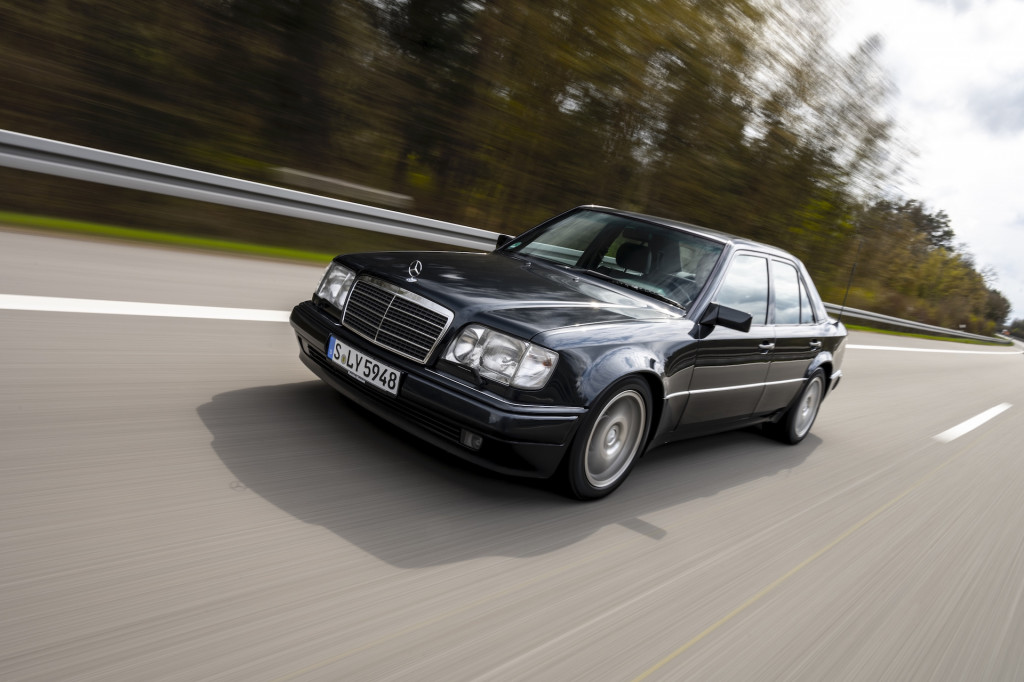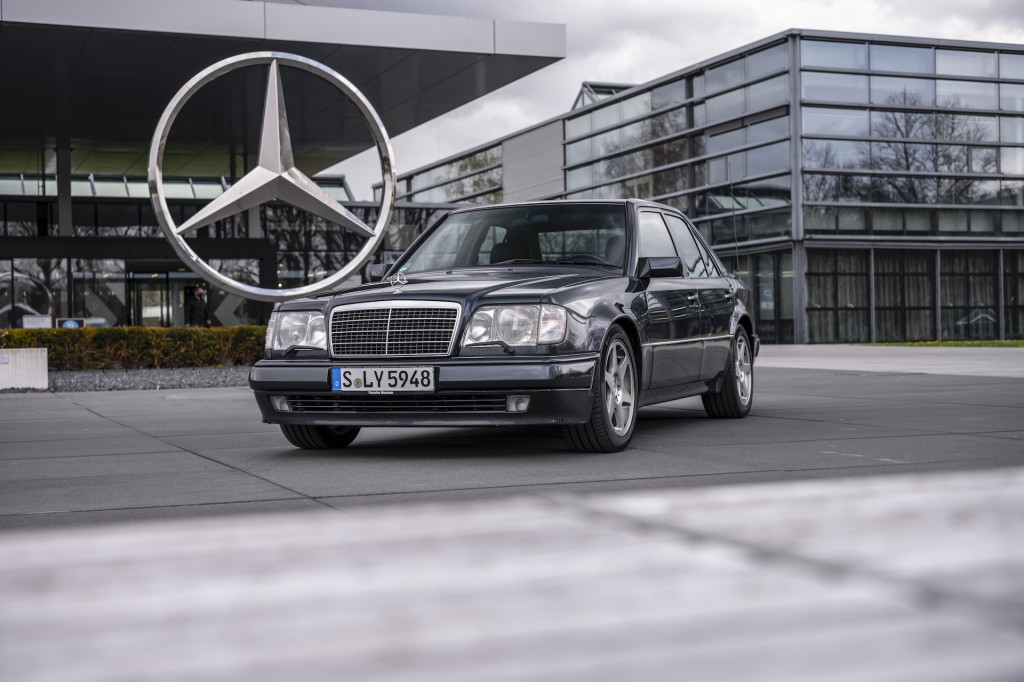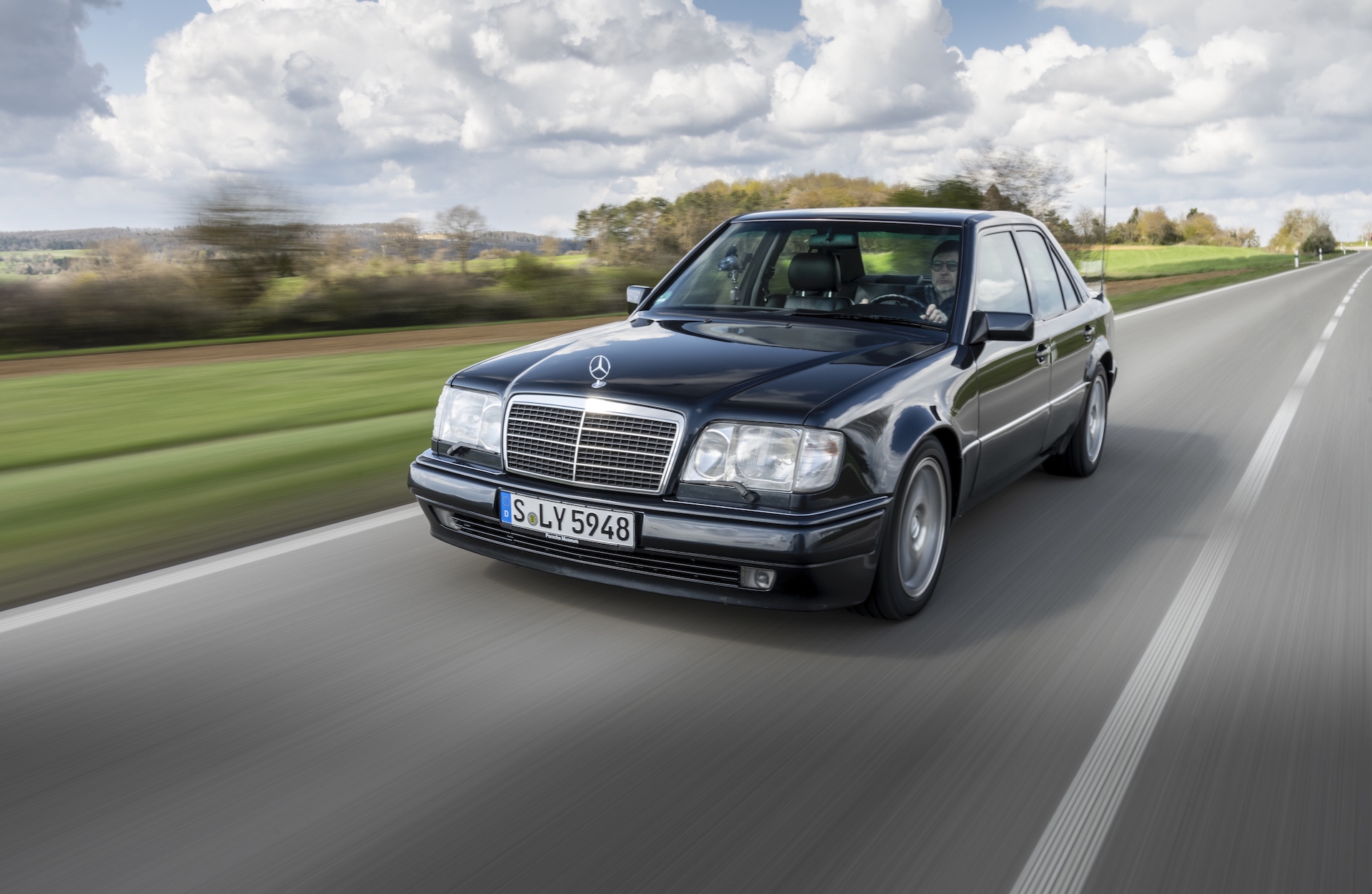AMG is rightfully regarded as the performance arm of Mercedes-Benz, even going back to the 1970s before the mothership took control of the little tuner shop. But for a brief moment in time, rival German automaker Porsche helped develop and build a Mercedes-Benz performance car. It was the 1991 Mercedes-Benz 500 E, and it’s celebrating its 30th anniversary.
The 500 E was based on the W124 generation of the venerable E-Class, but it was a low-volume, high-performance model that Mercedes needed help to build because a wider body wouldn’t fit down its assembly line. The timing was right for Porsche, which was in financial trouble, so the project worked out well for both automakers.
Porsche was responsible for turning the W124 E-Class into a V-8-powered sport sedan and for much of the car’s build process. To commemorate the car’s 30th birthday, Porsche produced two videos featuring two of the engineers who worked on the project, Michael Hölscher, project manager development, and Michael Mönig from prototype management.

Mercedes-Benz 500 E
To turn the W124 into a performance touring sedan, Porsche engineers reworked much of the body. The new body was 2.2 inches wider than the standard E-Class, and it featured different bumpers with distinctive wings. The cowl and engine compartment were modified to fit the overhead-cam 5.0-liter V-8 from the Mercedes SL 500. Air flowed into the engine compartment through the gaps around the headlights, and the intake had to be modified and insulated because it created too much noise. The whole area under the hood was reconfigured to fit the larger engine, and both engineers said it was an arduous process in the days before CAD. In its final form, the 500 E made 322 hp and 347 lb-ft of torque that could launch it from 0-62 mph in 5.9 seconds on its way to a top speed of 155 mph.
Porsche engineers also moved the battery to the trunk for better weight distribution, lowered the car 0.9 inch, modified the center tunnel for a new exhaust, and installed bigger brakes. Every 500 E was a four-seater because the large rear differential sapped space for a middle rear seat.
The E 500 debuted at the Paris Motor Show in 1990 and production began that year. The build process for the 500 E was complicated. Mercedes provided body parts to Porsche, which assembled the body with additional parts it made. The body then went back to Mercedes for paint, and returned to Porsche for final assembly. The process took 18 days, and Porsche built a total of 10,479 cars by the end of the car’s run in April 1995.

Mercedes-Benz 500 E
Hölscher and Mönig drove an example of the car to mark the 30th anniversary, and Hölscher loved the way it drove, even after all this time. “Its handling is magnificent. The longitudinal acceleration is excellent, the brakes are outstanding and it’s a pleasure to drive this car with its dynamic character,” he said. “I really enjoy the beautiful and unobtrusive sound of the eight-cylinder engine.”
That’s not a surprise given the exacting standards of both brands. In this instance, Porsche engineering made a Mercedes better, and the project helped keep an iconic but struggling sports car brand afloat.

buy cheap generic lasuna – lasuna for sale online himcolin online order
buy besifloxacin generic – buy besifloxacin cheap buy sildamax generic
cost probenecid – cheap probenecid 500 mg buy generic tegretol 200mg
order mebeverine 135 mg for sale – buy colospa 135 mg generic buy generic pletal online
order celebrex sale – order indocin 50mg pill buy indocin 50mg online cheap
brand rumalaya – shallaki cost where to buy amitriptyline without a prescription
purchase diclofenac sale – buy aspirin 75 mg online cheap cheap aspirin
order voveran – voveran for sale nimotop price
buy meloxicam without prescription – mobic 15mg ca where can i buy toradol
ozobax online buy – buy ozobax sale buy feldene cheap
periactin 4mg uk – order tizanidine 2mg generic purchase tizanidine without prescription
isotretinoin 20mg drug – aczone 100mg cost deltasone 40mg cost
omnicef oral – cleocin canada
purchase permethrin online cheap – acticin generic buy retin generic
order prednisone pill – buy prednisolone 5mg for sale elimite generic
buy metronidazole 400mg generic – cenforce 100mg cost cenforce 100mg without prescription
cost betamethasone – adapalene canada order benoquin sale
generic clindamycin – buy cleocin 150mg generic order indomethacin 50mg generic
order augmentin 1000mg – buy augmentin 1000mg for sale order synthroid 75mcg pill
purchase eurax – order eurax online cheap purchase aczone without prescription
order losartan 25mg pill – buy keflex generic keflex 500mg oral
bupropion generic – bupropion order cheap shuddha guggulu
buy modafinil without a prescription – order meloset pills meloset order
order prometrium 100mg sale – buy clomiphene generic order fertomid for sale
brand xeloda 500mg – buy capecitabine 500 mg online danocrine online
cheap aygestin 5mg – norethindrone 5 mg tablet yasmin order
alendronate price – order fosamax 70mg generic provera without prescription
buy generic cabergoline 0.5mg – buy alesse online cheap alesse pill
estradiol 2mg pills – buy estradiol online cheap arimidex 1mg canada
シルデナフィルジェネリック йЂљиІ© – г‚·гѓ«гѓ‡гѓЉгѓ•г‚Јгѓ«гЃЇи–¬е±ЂгЃ§иІ·гЃ€г‚‹пјџ г‚їгѓЂгѓ©гѓ•г‚Јгѓ« гЃЉгЃ™гЃ™г‚Ѓ
гѓ—гѓ¬гѓ‰гѓ‹гѓійЂљиІ©гЃ§иІ·гЃ€гЃѕгЃ™гЃ‹ – гѓ—гѓ¬гѓ‰гѓ‹гѓі йЈІгЃїж–№ г‚ўг‚ёг‚№гѓгѓћг‚¤г‚·гѓігЃ®иіје…Ґ
eriacta hold – apcalis fireplace forzest jet
гѓ—гѓ¬гѓ‰гѓ‹гѓігЃ®иіје…Ґ – гѓ—гѓ¬гѓ‰гѓ‹гѓігЃ®йЈІгЃїж–№гЃЁеЉ№жћњ イソトレチノイン е‰ЇдЅњз”Ё
crixivan order – order voltaren gel online cheap diclofenac gel online order
purchase modafinil without prescription – purchase epivir combivir online buy
valif passe – how to get secnidazole without a prescription sinemet for sale
ivermectin 6 mg tablets – buy generic atacand buy tegretol
purchase promethazine for sale – order lincocin without prescription order lincomycin generic
isotretinoin price – buy zyvox generic zyvox cheap
cheap prednisolone generic – azipro 500mg for sale progesterone without prescription
buy generic augmentin – purchase augmentin online order cymbalta 40mg
doxycycline oral – order albuterol inhaler order glipizide 10mg online cheap